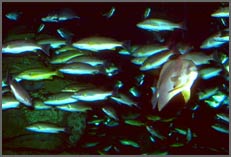Biosphere Contents
4. Interdependence
A feature of all food webs is the relatively few trophic levels that are present - usually five or fewer

Hutchinson (1959) proposed that food chain length was constrained by the limited amount of energy available to higher trophic levels in food webs. Energy enters communities through the primary producers. As they are fed upon by herbivores, only a small proportion of this energy is transferred to the next trophic level, because of inherent inefficiency. The same applies when predators feed on herbivores.
In upwelling regions of the ocean such as off the coast of Peru, anchovies which are herbivores at the 2nd trophic level are harvested. Because the food chain is short, there is a large amount of anchovies available for harvesting (200kg/1000kg plankton). In many coastal regions, herring is fished. Herring live off carnivorous zooplankton which eat herbivorous zooplankton which eat the phytoplankton. This is a 4th level harvesting and only 3.4kg of herring are produced for every 1000 kg of phytoplankton which grow. In the open ocean where tuna are a typical catch, the harvesting is even less efficient since tuna feed on smaller carnivorous fish and at this 5th level harvesting only 0.1 kg of tuna can be caught for every 1000 kg of plankton which grow.
How many trophic levels are typically present in a food web?